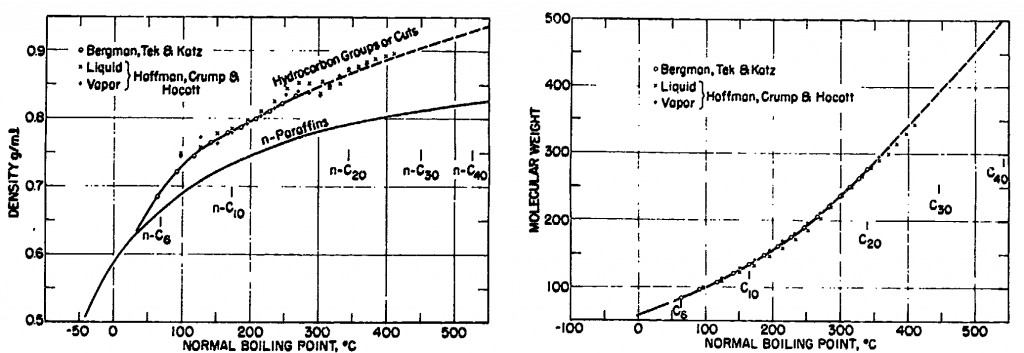Author: Bilal Younus
An EOS model requires five properties for each component in a mixture: critical pressure (pc), critical temperature (Tc), acentric factor (ω), molecular weight (M) and volume shift (s). The three first properties define the vapor pressure curve of the component, and the last two properties (parameter) ensures accurate prediction of liquid density for that component. The five properties are readily available for pure compounds.
The component properties of heavier constituents – often defined as single carbon number (SCN) fractions, containing many unknown isomers – must be estimated. Gas chromatography measures the mass amount for SCNs, but without information about the SCN properties. The SCN fraction estimation procedure relies on an M-Tb-γ relationship between molecular weight, normal boiling point (Tb), and liquid density at standard conditions (i.e. specific gravity, γ). That relationship will vary from one reservoir fluid system to another, and is primarily determined by the relative amounts of paraffins, naphthenes, and aromatics in each SCN. Experimental TBP distillation data from ASTM 2892 provides data to establish the M-Tb-γ relationship for SCNs from C6 to about C20+ (sometimes C25+). This relationship is specific for the reservoir fluid system being characterized.
Without ASTM 2892 data, assumptions and generalized (e.g. Katz-Firoozabadi) correlations must be used for the M-Tb-γ relationship, resulting in greater uncertainty in the prediction of EOS component properties and their mixtures.
In summary,
- C7+ component properties are not well defined and are normally different from one reservoir/field/basin to another depending on the relative “paraffinicity” or “aromaticity” of the fluid system.
- ASTM D2892 data provides a basis for generating the M-Tb-γ relationship based on actual, measured data from the field, resulting in a more robust and accurate characterization of the C7+ fractions used in the EOS.
- In the absence of ASTM D2892 data, the only data readily available for C7+ characterization is the measured average γ and MW of stock-tank or ambient-pressure flashed oils. This type of data has many limitations and drawbacks, not least being that the M-Tb-γ relationship is no longer unique to the fluid system being modelled.
Any reliable EOS calculation results require two sets of data (a) sample composition and (b) representative component properties. In any EOS characterization, there are always two types of components: (a) pure (library) components (e.g. CH4, CO2 etc.) and (b) C7+ hydrocarbon fractions which are mixtures of many pure components often grouped as single carbon number (e.g. C10, C11 etc.). The EOS properties of pure components are well known. However, for hydrocarbon fractions, properties depend on hydrocarbon type (aromatic, paraffinic, etc.) and the amount of different types of components present in each fraction.
As an example, the single carbon number C7 can have different proportions of benzene and normal heptane in crudes collected from different parts of the world. Benzene is an aromatic compound (MW=78.11 and γ =0.88) and normal heptane is normal paraffin (MW=100 and γ =0.687). Therefore, properties of C7 fraction depends on how much of benzene and normal heptane are present in the crude oil sample.
The ASTM D2892 data provide a basis for generating γ -MW and MW-Tb relationships based on actual, measured data from the field, which result in a more robust and accurate characterization of the C7+ fractions. One example is shown in Figure 1 taken from the classical SPE paper by Katz and Firoozabadi (1978). From Figure 1, it can be seen that the data measured in the field deviates from that of normal paraffins, indicating the aromatic character of the crude oils used in this particular study.

Figure 1: Developing γ -Tb and MW-Tb relationship for C7+ characterization for EOS modeling (Katz & Firoozabadi, 1978)
In the absence of ASTM D2892 data, the only data readily available for C7+ characterization is measured average γ and MW of C7+ fractions of stock tank oil or separator oil. This data can be used to develop MW- γ relationship and to estimate the degree of aromaticity and paraffinicity in crude oils from a specific field/reservoir/basin. However, such type of data has many limitations and drawbacks:
- There is no information on measured boiling points of different hydrocarbon fractions.
- The average C7+ MW and γ data covers usually a small range. C7+ MWs of stock tank condensates are usually in the range of 130-150 and for stock tank oils is 180-220. However, the C7 and heavier fractions MWs in EOS characterization usually range from 96 to 500. Therefore, this limited data range leaves high uncertainty in characterizing many EOS components for which the properties do not fall in the range of measured data.
- Sometimes the labs do not measure the average molecular weights and just calculate those using arbitrary molecular weights (e.g. Katz Firoozabadi 1978) for different fractions and sample composition. Such data is not representative of the true “character” (aromaticity/paraffinicity) of the sample collected and should not be used for C7+ characterization
Learn more about our consulting capabilities
###
Global
Curtis Hays Whitson
curtishays@whitson.com
Asia-Pacific
Kameshwar Singh
singh@whitson.com
Middle East
Ahmad Alavian
alavian@whitson.com
Americas
Mathias Lia Carlsen
carlsen@whitson.com
About whitson
whitson
supports energy companies, oil services companies, investors and government
organizations with expertise and expansive analysis within PVT, gas condensate
reservoirs and gas-based EOR. Our coverage ranges from R&D based industry
studies to detailed due diligence, transaction or court case projects. We help
our clients find best possible answers to complex questions and assist them in
the successful decision-making on technical challenges. We do this through a
continuous, transparent dialog with our clients – before, during and after our engagement.
The company was founded by Dr. Curtis Hays Whitson in 1988 and is a Norwegian
corporation located in Trondheim, Norway, with local presence in USA, Middle
East, India and Indonesia
